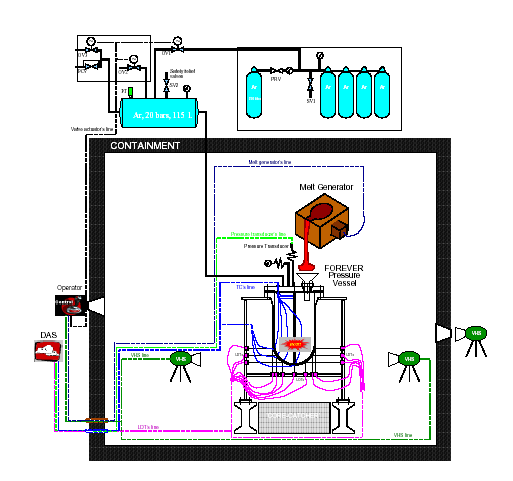FOREVER: Failure Of REactor VEssel Retention
The FOREVER facility employs a 1/10th scaled lower head (hemispherical in shape and made of SA533B, American reactor steel) of 400 mm outer diameter and 15 mm wall thickness. A cylindrical shell of 15Mo3-German steel, of 400 mm height and thickness of 15 mm, was welded to hemispherical lower head to make a complete vessel. A high temperature oxide melt (Tliq »1027 ºC) made of 30 wt%CaO-70 wt%B2O3 was melted in an inductively heated (50 kW max) SiC crucible. A custom made MOSi2 (45 kW max) electrical heater was employed to heat up the melt in the vessel and maintain a melt pool temperature of ~1300 oC. The corresponding external wall temperature (based on pre-test calculations ANSYS) should be in the range 950~1000 ºC. The vessel was pressurised to about 2.5 MPa using an argon reservoir in the EC-FOREVER-4 test.
The EC-FOREVER-4 experiment is the fifth in the new series of experiments on In-Vessel-Melt-Retention (IVMR) strategy, supported by the ARVI (Assessment of Reactor Vessel Integrity) project in the EC fifth Framework Program. It is also the seventh of the FOREVER tests performed at NPS/KTH in Sweden. It is an integral test to investigate the creep failure of a 1:10 scale reactor pressure vessel under the combined thermal and pressure loadings. This test simulates the late stages of the in-vessel melt progression in reactor severe accident scenarios. The main objective of the EC-FOREVER test is to obtain multi-axial creep deformation and vessel failure data for the scaled reactor vessel geometry under prototypical thermal and pressure loading conditions. The distinguishing feature of this test in comparison to the LHF and OLHF tests (performed at SNL, USA) is the high temperature conditions in the vessel (950-11000C) as compared to ~ 800ºC in all the LHF tests; and medium pressure, prototypic, loadings (2.5 MPa) as compared to 5 ~ 10 MPa in all the LHF tests.
The measurements were made with 34 thermocouples, 22 LPTs (Linear Position Transducer) and one pressure transducer. The thermocouples were located at 7 angular positions on either side of the vessel wall, both inside and outside, and also, at 6 different locations along the centreline in the melt pool. There were 5 LPT on similar angular positions on either side of outer vessel wall and one LPT at very bottom of the outer vessel wall, to measure the displacement due to initial thermal expansion and creep. Thin walled (~1 mm) steel tubes, 4 mm diameter, were used to protect the internal thermocouples from corrosive action of the melt. A KANTHAL tube of diameter 10 mm was employed to protect the centreline thermocouples.
The test conditions can be summarised as follows:
- Melt Volume » 12 litres.
- Power input in the melt » 38 kW.
- Maximum temperature in the melt pool » 1300 ºC.
- Maximum external wall temperature » 950 ºC.
- Internal pressure load » 2.5 MPa


Some results of the FOREVER experiments

